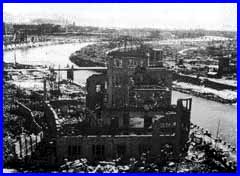
On August 6, 1945, the buildings in the downtown area of Hiroshima City were destroyed instantaneously by a single atomic weapon which left the area a scorched plain. The Industrial Promotion Hall was only 160 meters northwest from the hypocenter of the A-bomb. The building, which was destroyed by the bomb's blast and bathed in thermal rays, blew flames from its dome that devoured the entire structure. Nevertheless, because the blast from the bombing originated directly from above, the center of the building was miraculously spared collapse. At that time, all the people in the offices of the Internal Ministry's Chugoku-Shikoku Public Works Office, the Hiroshima District Lumber Control Corporation, the Hiroshima Branch of the Japan Lumber Corporation and the Hiroshima Ship Lumber Corporation died instantly. Many last writings and messages asking for the whereabouts of family members and friends were written on the wall of the building, which remained standing at the hypocenter.

(Photo: Courtesy of Hiroshima Peace Culture Foundation)
You can look the CG of the dome.
http://www.urban.ne.jp/home/kibochan/miyakou/cg.htm
The name "A-Bomb Dome" came about naturally among the citizens of Hiroshima due to the circular shape of the umbrella-like skeletal remains of the roof. When people started using this name is unclear. In the beginning of 1945, the name was not yet being used commonly, but by August 6, 1951, the name had appeared in large headlines in the Chugoku Shimbun newspaper, such as "Diary of the A-Bomb Dome."
A short time after the atomic bombing, a scholastic fact-finding mission to the dome took place, and by September 1949, the city's recovery allowed many people to visit the dome, including Japanese-Americans visiting their homes from Hawaii, visitors from abroad allied forces troops that were stationed in Japan at that time, elementary students on school excursions, and sightseers. Nevertheless, in 1950, the area surrounding the dome became overgrown with weeds, and damage such as cracks in the walls around the building had gradually become more pronounced. Even after the A-Bomb Dome was transferred from the prefecture to the city on November 14, 1953, the breakdown of the building continued without any kind of conclusion at all in the midst of the argument whether the Dome should exist at all. Small-scale destruction and disintegration continued until the building became a hazard. Eventually, in 1962, a wire fence was built around the vicinity of the building, sealing off the building's interior into which people were forbidden to enter.